
Werner Herzog is a German filmmaker, actor, opera director, and author. Regarded as a pioneer of New German Cinema, his films often feature ambitious protagonists with impossible dreams, people with unusual talents in obscure fields, or individuals in conflict with nature. His style involves avoiding storyboards, emphasizing improvisation, and placing his cast and crew into real situations mirroring those in the film they are working on.
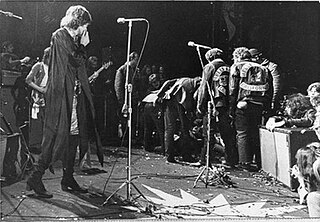
The Altamont Speedway Free Festival was a counterculture rock concert in the United States, held on Saturday, December 6, 1969, at the Altamont Speedway outside of Tracy, California. Approximately 300,000 attended the concert, with some anticipating that it would be a "Woodstock West". The Woodstock festival had taken place in Bethel, New York, in mid-August, almost four months earlier.
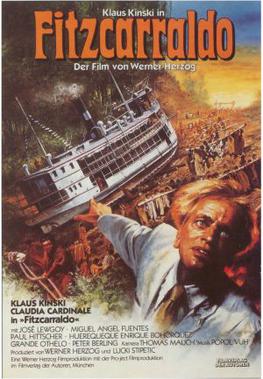
Fitzcarraldo is a 1982 West German epic adventure-drama film written, produced, and directed by Werner Herzog, and starring Klaus Kinski as would-be rubber baron Brian Sweeney Fitzgerald, an Irishman known in Peru as Fitzcarraldo, who is determined to transport a steamship over the Andes mountains to access a rich rubber territory in the Amazon basin. The character was inspired by Peruvian rubber baron Carlos Fitzcarrald, who once transported a disassembled steamboat over the Isthmus of Fitzcarrald.
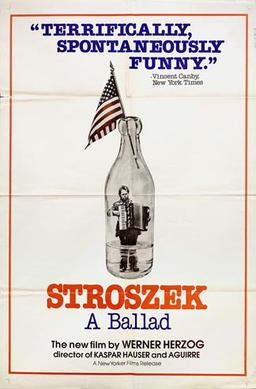
Stroszek is a 1977 West German tragicomedy film directed by Werner Herzog and starring Bruno S., Eva Mattes, and Clemens Scheitz. Written specifically for Bruno S., the film was shot in Plainfield, Wisconsin, and North Carolina. Most of the lead roles are played by inexperienced actors.
Bells from the Deep: Faith and Superstition in Russia is a 1993 documentary film written and directed by Werner Herzog, produced by Werner Herzog Filmproduktion.
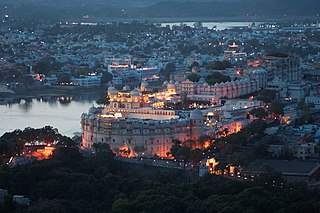
Udaipur is a city in the north-western Indian state of Rajasthan, about 415 km (258 mi) south of the state capital Jaipur. It serves as the administrative headquarters of Udaipur district. It is the historic capital of the kingdom of Mewar in the former Rajputana Agency. It was founded in 1559 by Udai Singh II of the Sisodia clan of Rajputs, when he shifted his capital from the city of Chittorgarh to Udaipur after Chittorgarh was besieged by Akbar. It remained as the capital city till 1818 when it became a British princely state, and thereafter the Mewar province became a part of Rajasthan when India gained independence in 1947. It is also known as the City of Lakes, as it is surrounded by five major artificial lakes.

The Great Ecstasy of Woodcarver Steiner is a 1974 documentary film by German filmmaker Werner Herzog. It is about Walter Steiner, a celebrated ski jumper of his era who worked as a carpenter for his full-time occupation. Showcased is Steiner's quest for a world record in ski flying, as well as the dangers involved in the sport. Herzog has considered it one of his "most important films."
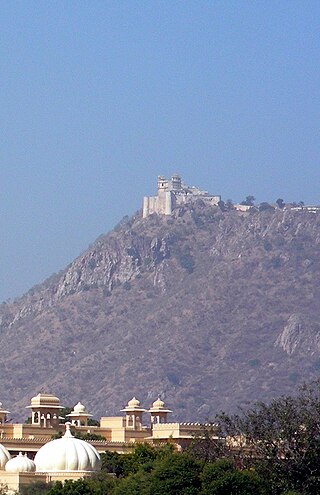
The Monsoon Palace, also known as the Sajjan Garh Palace, is a hilltop palatial residence in the city of Udaipur, Rajasthan in India, overlooking the Fateh Sagar Lake. It is named Sajjangarh after Maharana Sajjan Singh (1874–1884) of the Mewar dynasty, whom it was built for in 1884. The palace offers a panoramic view of the city's lakes, palaces and surrounding countryside. It was built chiefly to watch the monsoon clouds; hence, appropriately, it is popularly known as Monsoon Palace. It is said that the Maharana built it at the top of the hill to get a view of his ancestral home, Chittorgarh. Previously owned by the Mewar royal family, it is now under the control of the Forest Department of the Government of Rajasthan and has recently been opened to the public. The palace provides a beautiful view of the sunset.

Herakles (Heracles) is a 1962 short film and the first film by the German director Werner Herzog, then 19 years old.
Gesualdo: Death for Five Voices is a 1995 film by German director Werner Herzog filmed for ZDF television. The film explores the music of Carlo Gesualdo and the legends surrounding Gesualdo's personality, his cursed castle, and his murder of his wife and her lover. Between narration and interviews, several of Gesualdo's madrigals are performed. Herzog calls Death for Five Voices "one of the films closest to my heart."
Game in the Sand is an unreleased short film written and directed by Werner Herzog in 1964. The plot concerns four children and a rooster in a cardboard box, and includes a scene where the chicken is buried in sand up to its neck. Very little information about the film and its production is known.

Encounters at the End of the World is a 2007 American documentary film by Werner Herzog about Antarctica and the people who choose to spend time there. It was released in North America on June 11, 2008, and distributed by ThinkFilm. At the 81st Academy Awards, the film was nominated for Best Documentary Feature.

Lake Palace is a former summer palace of the royal dynasty of Mewar, it is now turned into a hotel. The Lake Palace is located on the island of Jag Niwas in Lake Pichola, Udaipur, India, and its natural foundation spans 4 acres (16,000 m2). Popularly described as the Venice of the East, Udaipur hosts the pristine Lake Palace, curated out of white marble.

Shiv Niwas Palace is a former residence of the Maharana of Udaipur, Rajasthan, located on the banks of Lake Pichola.

Ballad of the Little Soldier is a 1984 documentary film directed by Werner Herzog and Denis Reichle about child soldiers in Nicaragua. The film focuses on a group of Miskito Indians who used children soldiers in their resistance against the Sandinistas.

The culture of Rajasthan includes many artistic traditions that reflect the ancient Indian way of life. This historical state of India attracts tourists and vacationers with its rich culture, tradition, heritage and monuments.

City Palace, Udaipur is a palace complex situated in the city of Udaipur in the Indian state of Rajasthan. It was built over a period of nearly 400 years, with contributions from several rulers of the Mewar dynasty. Its construction began in 1553, started by Maharana Udai Singh II of the Sisodia Rajput family as he shifted his capital from the erstwhile Chittor to the newfound city of Udaipur. The palace is located on the east bank of Lake Pichola and has several palaces built within its complex.

Jag Mandir is a palace built on an island in the Lake Pichola. It is also called the "Lake Garden Palace". The palace is located in Udaipur city in the Indian state of Rajasthan. Its construction is credited to three Maharanas of the Sisodia Rajputs of Mewar kingdom. The construction of the palace was started in 1551 by Maharana Amar Singh, continued by Maharana Karan Singh (1620–1628) and finally completed by Maharana Jagat Singh I (1628–1652). It is named as "Jagat Mandir" in honour of the last named Maharana Jagat Singh. The royal family used the palace as a summer resort and pleasure palace for holding parties. The palace served as a refuge to asylum seekers for one occasion.

Lake Pichola, situated in Udaipur city in the Indian state of Rajasthan, is an artificial fresh water lake, created by RANA LAKHA/LAKSH SINGH in the year 1387, named after the nearby Picholi village. It is one of the several contiguous lakes, and developed over the last few centuries in and around the famous Udaipur city. The lakes around Udaipur were primarily created by building dams to meet the drinking water and irrigation needs of the city and its neighbourhood. Two islands, Jag Niwas and Jag Mandir are located within Pichola Lake, and have been developed with several palaces to provide views of the lake.















